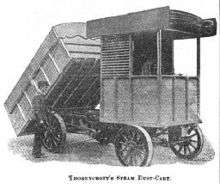Thornycroft

Thornycroft was a United Kingdom-based vehicle manufacturer which built coaches, buses, and trucks from 1896 until 1977.
History

.jpg)
John Isaac Thornycroft, the naval engineer, also formed the Thornycroft Steam Carriage and Van Company which built its first steam van in 1896. This was exhibited at the Crystal Palace show, and could carry a load of 1 ton. It was fitted with a Thornycroft marine launch boiler (Thornycroft announced a new boiler designed for their steam carriages in October 1897[1]). The engine was a twin-cylinder compound engine arranged so that high-pressure steam could be admitted to the low-pressure cylinder to give extra power for hill-climbing.[2] A modified version of the steam wagon with a 6-cubic-yard tipper body was developed for Chiswick council in 1896 and went into service as a very early self-propelled dust-cart. While the original 1896 wagon had front-wheel drive with rear-wheel steering, the tipper dust-cart had rear-wheel drive and front-wheel steering. The Thornycroft tipper was built by the Bristol Wagon and Carriage Company, though engined by Thornycroft.[3]
Thornycroft's first petrol vehicle was built in 1902, and the company completed the move into internal combustion engine power in 1907. Thereafter the vehicle building firm and the marine side (later to become Vosper Thornycroft) were separate companies.
From 1931, Thornycroft used names for their vehicle range – descriptive and colourful ones.
In 1948, the company name was changed to Transport Equipment (Thornycroft) Ltd to prevent confusion with the shipbuilding Thornycroft company. The company was well known for providing fire-engine chassis, with multi-axle drive for uses such as airports.
They were taken over in 1961 [4] by AEC parent Associated Commercial Vehicles Ltd, and production was limited to Nubians, Big Bens and Antars, although the Thornycroft-designed six-speed constant mesh gearbox was used in AEC and later medium weight Leyland and Albion trucks. ACV was then taken over by Leyland in 1962. They already had a specialist vehicle unit in Scammell, another manufacturer of large haulage vehicles. Thornycroft's Basingstoke factory was closed in 1969 and specialist vehicles transferred to Scammell at Watford. The factory continued as an engineering works until the late 1980s when it was demolished to make way for a supermarket. The Milestones Museum is located a few hundred yards from the original site in Basingstoke and houses a collection of Thornycroft vehicles and other exhibits, mainly transport related.
Today, the Thornycroft name is used by a builder of marine diesel engines for private and light commercial use, the engines being based around small-capacity engines designed by Mitsubishi. Despite Thornycroft being effectively closed down by Leyland, the operation's parent company is now the main provider of spare parts for Leyland-built marine diesels, which for many years were highly popular for use in canal barges and narrowboats (now a market making increasing use of modern-day Thornycroft engines).
Models
Bus and Coach
- Beautyride
- Boudicea
- Cygnet
- Daring
- Lightning
- Nippy
- Patrician
Lorry
- "Type J" 40 hp, 1913
- "Type K" 30 hp, 1913
- Hathi, 1924
- four-wheel drive artillery tractor for the army
- A1 RSW / A3 RSW, an off-road capable rigid six-wheeler to an army specification, 1926[5]
- QC / Dreadnought, 1930
- 12 ton rigid six-wheel chassis.[6]
- Hardy
- Dandy
- Sturdy - 5/6 tonner
- Trusty - 8 ton forward control 4 wheeler
- Bullfinch
- Strenuous
- Mastiff
- Tartar 3-ton 6x4, both civilian & military versions and production (3,000 - 4,000) between 1938 and 1945.
- (see Thornycroft Bison for an unusual variant)
- Taurus
- Iron Duke
- Amazon
- Stag
- Bulldog
- Jupiter - 6.5 ton
- Big Ben
- Nubian
- 3-ton vehicle
- Available as 4 x 4, 6 x 4, 6 x 6
- Antar
- 85-ton
- 6 x 4 pipeline and tank transporter
See also
- Terrapin - design only, built by Morris Commercial
- Nubian airport crash tender
- Thornycroft military vehicles
- Thornycroft Athletic F.C.
References
- ↑ "Messrs Thornycroft's new Automotor boiler", The Automotor and Horseless Carriage Journal, October 1897, pp2-4
- ↑ "Recent Developments in Mechanical Road Carriages", The Automotor and Horseless Vehicle Journal, Dec 1896, pp89-91
- ↑ "An automobile dust-cart", The Automotor and Horseless Carriage Journal, Oct 1897, p24
- ↑ Commercial Motor Archives http://archive.commercialmotor.com/article/10th-february-1961/37/aecthornycroft-no-change-for-present
- ↑ "Type A1 RSW". Hants gov, Thornycroft.
- ↑ "Type QC lorry". Hants gov, Thornycroft.
External links
| Wikimedia Commons has media related to Thornycroft vehicles. |
|
|
- 'Thornycroft of Basingstoke' - (Hampshire Cultural Trust) - extensive coverage of history and vehicles
- Thornycroft vehicle preservation group
- Thorneycroft Classic Motor History